Northern Red Snapper
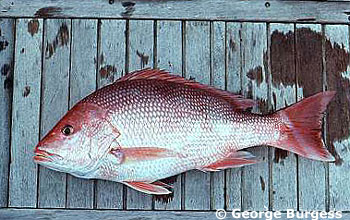
Lutjanus campechanus
These off-shore fish prefer deep reefs or rocky banks int he Western Atlantic. They’re a dark pink-red, fading to pale underbelly, and younger, smaller fish sometimes have a dark spot high on their sides. They are classically almond-shaped, with red eyes, and dorsal and anal fins that taper to points near the caudal fin. Generally they grow to 24 inches long, but some have been caught as big as 39 inches and 20 pounds.
Order: Perciformes
Family: Lutjanidae
Genus: Lutjanus
Species: campechanus
Common Names
English language common names include northern red snapper, sow snapper, rat snapper, mule snapper, chicken snapper, gulf red snapper, american red snapper, caribbean red snapper, pensacola red snapper, mexican red snapper, red snapper, mutton snapper, and bream. Other common names are acara aya (Spanish), boca negra (Papiamento), chillo (Spanish), cora (Papiamento), huachinango del golfo (Spanish), luciano-do-golfo (Portuguese), pargre fine (French), pargo (Papiamento), pargo colorado (Spanish), pargo del golfo (Spanish), pargo guachinango (Spanish), parge real (Spanish), roodvis (Dutch), sarde rouge (French), vermelho (Portuguese), vivaneau campeche (French), vivanot jolle-bleu (French).
Importance to Humans
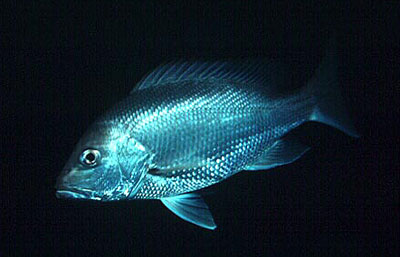
The northern red snapper is a popular game fish and is highly prized table fare. Eight million pounds of this snapper are caught in American waters each year. Most commercial fishing is done with electric and hydraulic reels with anywhere from 2 to 40 hooks on each line. Ladyfish and squid are the two most effective baits for catching the northern red snapper. They are also caught with handlines, bottom longlines, and bottom trawls.
Danger to Humans
There have been reports of ciguatera poisoning from human consumption of yellowtail snappers although such instances are considered rare for this species. Ciguatera poisoning is caused by dinoflagellates (microalgae) found on dead corals or macroalgae. By feeding on these corals and macroalgae, herbivorous fishes accumulate a toxin generated by these dinoflagellates. Largely a phenomenon of tropical marine environments, ciguitoxin accumulates still further in snappers and other large predatory reef species that feed on these herbivorous fishes. If accumulated levels of the toxin are great enough they can cause poisoning in humans whom consume the flesh of these fishes. Poisoned people report having gastrointestinal problems for up to several days, and a general weakness in their arms and legs. It is very rare to be afflicted with ciguatera poisoning.
Conservation Status
The shrimp industry has had a major impact on the northern red snapper populations due to by-catch of young fish in shrimp trawls. This has been a source of conflict between shrimpers and snapper fishermen for years. It has been suggested that shrimping should be closed in certain areas during critical times of the year to minimize the impact on the snapper fishery. Also, commercial and sportfishing activities have resulted in declining populations of the northern red snapper. The U.S. government has recently established catch limits for the northern red snapper. At this time, the World Conservation Union (IUCN) does not consider this snapper to be vulnerable or threatened.
> Check the status of the northern red snapper at the IUCN website.
Geographical Distribution
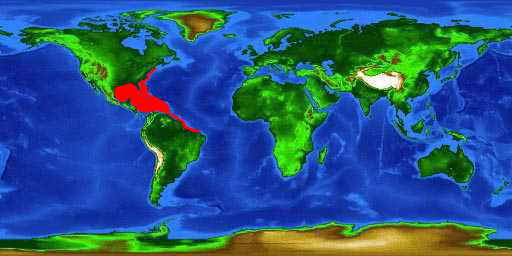
This snapper is found in the western Atlantic Ocean, from Massachusetts to Brazil, although it is uncommon north of the Carolinas. It is also occurs in the Gulf of Mexico.
Habitat
The adult northern red snapper lives offshore on the continental shelf, over deep reefs, banks, and rocky bottoms. Populations residing amongst such three-dimensional structures are usually larger than those in smooth bottom areas. Adults of this species are found at depths of 33-620 feet (10 to 190m) with older, larger fish tending to prefer the cooler, deeper spots. The young live over sandy and muddy bottoms that provide a rich food supply of shellfish for the foraging juvenile fish. As the juveniles mature, they seek cover in the form of ledges, rocky outcroppings, and wrecks. During winter northern red snapper move offshore to avoid the cooler, shallow inshore waters.
Biology
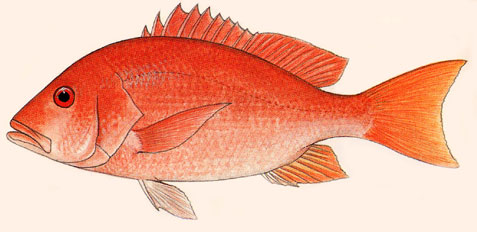
Distinctive Features
This snapper has long pectoral fins and a truncate caudal fin. The first and second dorsal fins are continuous with a slight notch in between the two and the anal fin tapers to a point posteriorly. The pectoral fins are long and reach the anus when pressed against the body. They have a large head with small red eyes and a somewhat pointed snout.
Coloration
The body and fins are pinkish red in color, lightening to a white underside. At a size less than 14 inches (35cm) northern red snapper have a dark spot on the upper sides below the anterior soft dorsal rays – similar to a number of other snappers. And although they may most closely resemble the blackfin snapper (L. buccanella), the northern red snapper lacks the distinctive black spot found on the pectoral fins of the blackfin snapper. Juvenile red snapper may also exhibit bluish stripes on their sides.
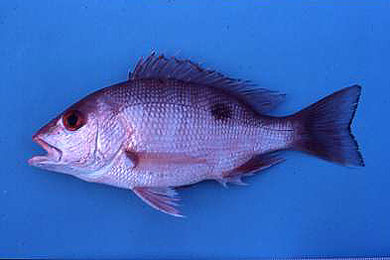
Dentition
Although most teeth in the upper jaw are densely packed, fine, or hair like “villiform” teeth, there are several canine teeth present as well – the latter constituting a definitive characteristic of all snappers. The lower jaw, which projects slightly beyond the upper, has larger villiform teeth.
Size, Age, and Growth
The northern red snapper reaches an average length of 24 inches (60cm), with a maximum length of 39 inches (100cm) and may weigh up to 20 pounds. Sexual maturity is reached at 2 years, at which time northern red snapper are typically12-16 inches (30-40cm) in length. Maximum age is estimated at 40-50 years. This snapper grows approximately 4 inches per year for the first 6 years followed by a generally declining growth rate thereafter.
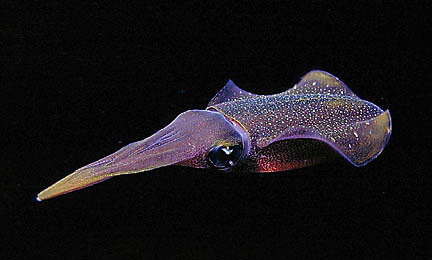
Food Habits
Both juvenile and adult northern red snapper are carnivorous, and adults are bottom-oriented predators. Juveniles commonly feed on zooplankton. But as they mature, their diet switches over to larger prey including shrimp, squid, and octopus. Adult northern red snapper feed on a variety of smaller fishes, crustaceans, and mollusks, which they find in flat bottom areas adjacent to the reefs.
Reproduction
All snapper are oviparous. Northern red snapper spawn in areas away from reefs, at depths of 60-120 feet (18-37m) over flat sand bottom areas. The peak spawning period is June through August in the northwestern Gulf of Mexico, and from August to September off southwestern Florida. Individual fish may spawn several times during the spawning season, and may produce over 9 million eggs during a single spawning event. Northern red snapper eggs are pelagic, spherical and transparent, measuring 0.8mm in diameter. After spawning, the eggs are buoyant, floating on the surface of the water. The eggs hatch 20-27 hours after fertilization. The larvae are very small (2.2mm) and vulnerable to starvation and predation. Initially planktonic, they begin to settle out of the water column after about 20 days. The larvae settle on areas with some protection from predators, such as open shell beds. Juveniles have bands below the dorsal fin, the darkest of which appears below the second dorsal fin. As the juveniles mature, they move to the reefs where they stay as adults.
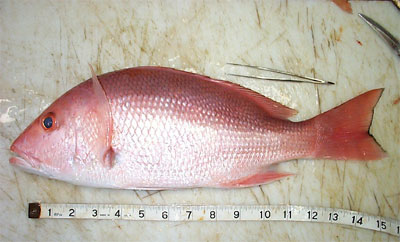
Predators
Predators of adult northern red snapper include sharks and other large piscivorous fishes. Juvenile red snapper are prey for a wide variety of marine organisms.Parasites
Parasitic leeches have been found attached to the gills of the northern red snapper.
Taxonomy
The famous Cuban ichthyologist, Felipe Poey described the northern red snapper in 1860 as Mesoprion campechanus. Synonyms include Lutjanus campechianus Poey 1870 and Lutjanus blackfordii Goode and Bean 1878. For many years, taxonomic confusion led numerous authors to incorrectly refer to this species as Lutjanus aya.
Prepared by: Cathleen Bester